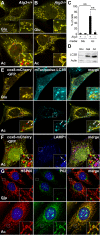Elimination of paternal mitochondria in mouse embryos occurs through autophagic degradation dependent on PARKIN and MUL1
- PMID: 27852436
- PMCID: PMC5127638
- DOI: 10.7554/eLife.17896
Elimination of paternal mitochondria in mouse embryos occurs through autophagic degradation dependent on PARKIN and MUL1
Abstract
A defining feature of mitochondria is their maternal mode of inheritance. However, little is understood about the cellular mechanism through which paternal mitochondria, delivered from sperm, are eliminated from early mammalian embryos. Autophagy has been implicated in nematodes, but whether this mechanism is conserved in mammals has been disputed. Here, we show that cultured mouse fibroblasts and pre-implantation embryos use a common pathway for elimination of mitochondria. Both situations utilize mitophagy, in which mitochondria are sequestered by autophagosomes and delivered to lysosomes for degradation. The E3 ubiquitin ligases PARKIN and MUL1 play redundant roles in elimination of paternal mitochondria. The process is associated with depolarization of paternal mitochondria and additionally requires the mitochondrial outer membrane protein FIS1, the autophagy adaptor P62, and PINK1 kinase. Our results indicate that strict maternal transmission of mitochondria relies on mitophagy and uncover a collaboration between MUL1 and PARKIN in this process.
Keywords: autophagy; cancer biology; mitochondria; mitophagy; mouse.
Conflict of interest statement
The authors declare that no competing interests exist.
Figures











Similar articles
-
Autophagy machinery in the context of mammalian mitophagy.Biochim Biophys Acta. 2015 Oct;1853(10 Pt B):2797-801. doi: 10.1016/j.bbamcr.2015.01.013. Epub 2015 Jan 26. Biochim Biophys Acta. 2015. PMID: 25634658 Review.
-
MiT/TFE transcription factors are activated during mitophagy downstream of Parkin and Atg5.J Cell Biol. 2015 Aug 3;210(3):435-50. doi: 10.1083/jcb.201501002. J Cell Biol. 2015. PMID: 26240184 Free PMC article.
-
Regulation by mitophagy.Int J Biochem Cell Biol. 2014 Aug;53:147-50. doi: 10.1016/j.biocel.2014.05.012. Epub 2014 May 16. Int J Biochem Cell Biol. 2014. PMID: 24842103 Review.
-
Counteracting PINK/Parkin Deficiency in the Activation of Mitophagy: A Potential Therapeutic Intervention for Parkinson's Disease.Curr Neuropharmacol. 2016;14(3):250-9. doi: 10.2174/1570159x13666151030104414. Curr Neuropharmacol. 2016. PMID: 26517048 Free PMC article. Review.
-
The three 'P's of mitophagy: PARKIN, PINK1, and post-translational modifications.Genes Dev. 2015 May 15;29(10):989-99. doi: 10.1101/gad.262758.115. Genes Dev. 2015. PMID: 25995186 Free PMC article. Review.
Cited by
-
Cdc14 spatiotemporally dephosphorylates Atg13 to activate autophagy during meiotic divisions.J Cell Biol. 2022 May 2;221(5):e202107151. doi: 10.1083/jcb.202107151. Epub 2022 Mar 3. J Cell Biol. 2022. PMID: 35238874 Free PMC article.
-
Mechanisms of mitophagy in cellular homeostasis, physiology and pathology.Nat Cell Biol. 2018 Sep;20(9):1013-1022. doi: 10.1038/s41556-018-0176-2. Epub 2018 Aug 28. Nat Cell Biol. 2018. PMID: 30154567 Review.
-
Crosstalk between mitochondrial biogenesis and mitophagy to maintain mitochondrial homeostasis.J Biomed Sci. 2023 Oct 12;30(1):86. doi: 10.1186/s12929-023-00975-7. J Biomed Sci. 2023. PMID: 37821940 Free PMC article. Review.
-
The mitophagy pathway and its implications in human diseases.Signal Transduct Target Ther. 2023 Aug 16;8(1):304. doi: 10.1038/s41392-023-01503-7. Signal Transduct Target Ther. 2023. PMID: 37582956 Free PMC article. Review.
-
Autophagy of an Amyloid-like Translational Repressor Regulates Meiotic Exit.Dev Cell. 2020 Jan 27;52(2):141-151.e5. doi: 10.1016/j.devcel.2019.12.017. Dev Cell. 2020. PMID: 31991104 Free PMC article.
References
MeSH terms
Substances
Grants and funding
LinkOut - more resources
Full Text Sources
Other Literature Sources
Molecular Biology Databases
Research Materials

